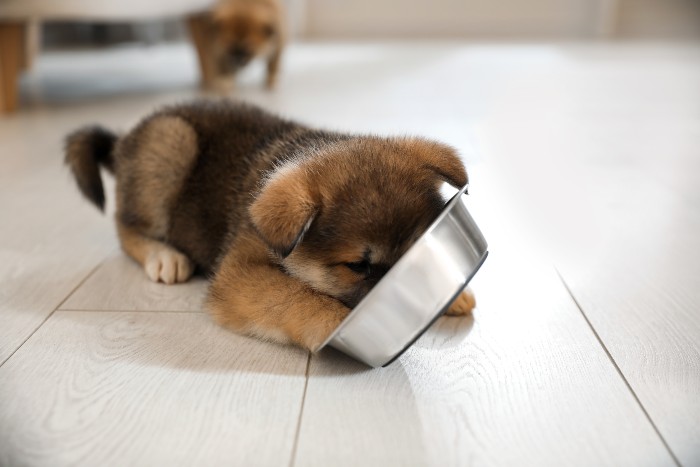How to Choose the Right Food for Your Puppy

DogFoodAdvisor is reader supported See how
Dog Food Advisor is 100% impartial and is never paid to promote any brand. But if you buy using links on this page, we may earn a referral fee.
Bringing a new puppy into your home involves more than just a warm welcome. From puppy-proofing your space to initiating crate training and potty training, there’s a lot to consider.
Choosing the right puppy food is a crucial aspect of ensuring your furry friend’s growth and overall health. While it may seem daunting, selecting the perfect diet for your puppy isn’t as difficult as you might think, provided you keep a few essential factors in mind.
This article will discuss the different types of diets you might be considering and some advice to keep in mind when choosing puppy food.
What diet should I start my puppy on?
Welcoming a new puppy into your home can be overwhelming for them. Having recently transitioned from their mother’s milk to solid food, and with their digestive systems and microbiome still in the developmental stage, their little tummies are often quite sensitive.
They have also entered an entirely new home, leaving their mother and siblings behind so they are likely to be anxious. Therefore, it’s advisable to try to stick to one food and not switch between lots of different kinds.
Do some research before getting your puppy and select a complete and balanced diet tailored to their age and breed, providing the stability needed during this transitional period.
However, if you’ve tried a specific food for a month or so and it’s not suiting the puppy, a change can be made — just do it gradually to avoid any potential upset tummy issues.
What type of diet is suitable for a puppy?
Generally, every type of diet can be suitable for puppies so long as they are formulated to be complete and balanced to meet the standards of AAFCO and have all life stages or growth nutritional profiles.
Is a raw diet food for a puppy?
Raw diets can be suitable for puppies but it’s best to opt for a professionally formulated food as opposed to homemade. Puppies have very specific nutritional requirements and need to meet these requirements so following the 80:10:10 method is not recommended at this stage.
You will also need to be careful of Salmonella and other bacteria — with a raw diet, but also any other type of dog food — as puppies are more susceptible to illness from these types of bacteria than adult dogs.
Is a kibble diet good for a puppy?
Kibble can be a great choice as it’s usually commercially prepared to be completed and balanced. However, depending on their age and development, you might need to soak the kibble in warm water to protect their developing teeth.
Is a fresh diet good for a puppy?
Much like the raw diet, a fresh diet is a good option as long as it meets the standards of AAFCO. It’s best to get one formulated by a professional rather than making the food yourself to ensure your puppy is getting the essential nutrients.
Is a wet food diet good for a puppy?
Puppies often gobble up wet food because it’s easy to chew and it includes lots of moisture, so it’s hydrating.
The foods can be fed slightly warm as a comfort and to increase the scents and palatability.
Overall, it can come down to what suits the owner’s lifestyle, the puppy’s preferences, or any health concerns your puppy might have. If you are unsure about choosing the correct diet, your vet will be happy to discuss which is best for your new puppy.
Why puppy food?
It’s essential to choose a puppy-specific food. Since your puppy is growing, they need more nutrients and calories than an adult dog. This is why puppy foods have a higher level of protein and fat to support growth, as well as nutrients like DHA, an omega fatty acid found in mother’s milk.
Once your puppy reaches adulthood, they don’t need as many calories. So when they are around 10-12 months for small breeds, 12-18 months for medium/large breeds, and around 18-24 months for giant breeds, it’s time to change over to adult food.
What to look for in puppy food
Complete and balanced
If you are buying commercially made dog food, check if the label reads: complete and balanced for Growth or All Life Stages. This means the food meets the standards of the AAFCO and is recommended for healthy puppies without existing veterinary conditions or particular nutritional needs.
Expected Adult Size
If your puppy is a large or giant breed (those expected to weigh over 50 pounds as an adult), consider using a puppy food formulated especially for large or giant-breed dogs.
Large and giant breeds also reach their adult size later than small and medium breeds.
Large breeds usually reach their adult size at 18 months and for giant breeds, at two years.
Using a large breed of puppy food for the later stages of growth rather than adult food will save your dog from receiving too much calcium which compromises skeletal development in large breeds.
You can read more about this in our article on large-breed puppies here: https://www.dogfoodadvisor.com/best-dog-foods/best-large-breed-puppy-food/
Breed
Numerous dog foods are labeled as “breed-specific,” while they may not be essential for your growing puppy, they can offer benefits. These diets often provide kibble sizes tailored to your puppy’s preferences and a nutrient profile designed for your dog’s breed.
While many breeds share similar nutritional needs, breed-specific foods may offer features that cater to specific breed predispositions and characteristics.
Ingredient list
There are no specific ingredients to look for when choosing the best puppy food, but pet parents must ensure the food is made by a reputable company and contains high-quality ingredients.
Does your puppy have any dietary needs?
Although only a small percentage of allergies are diet-related, if you do think your puppy is having an allergic reaction, check with your vet and they will be able to advise.
What are the best treats for my puppy?
Rewarding your puppy with a treat is a great way of rewarding good behavior and is one of the best tools you have when it comes to puppy training. If your new puppy is a food lover (and most are) you can easily show them the benefits of behaving well, both inside and outside the home.
But as is the case with mealtimes, it’s important to make sure you’re not overfeeding them and that you’re giving them treats that are nutritious and part of a balanced diet. Treat intake should not surpass 10% of your dog’s daily calories.
Choosing appropriate treats can play a big part in keeping your puppy both happy and healthy. Here are some things to look out for when buying your puppy treats:
- Treats specifically for puppies
- Tiny pieces
- Healthy ingredients.
Despite the overwhelming choice in the pet store, choosing a puppy food doesn’t have to be a daunting task. Whether you opt for a raw, kibble, fresh, or wet food diet, the key is to choose a complete and balanced option tailored to your puppy’s age and breed.
Final word
The Dog Food Advisor does not accept money, gifts, samples or other incentives in exchange for special consideration in preparing our reviews.
However, we do receive a referral fee from online retailers (like Chewy or Amazon) and from sellers of perishable pet food when readers click over to their websites from ours. This helps cover the cost of operation of our free blog. Thanks for your support.
For more information, please visit our Disclaimer and Disclosure page.



